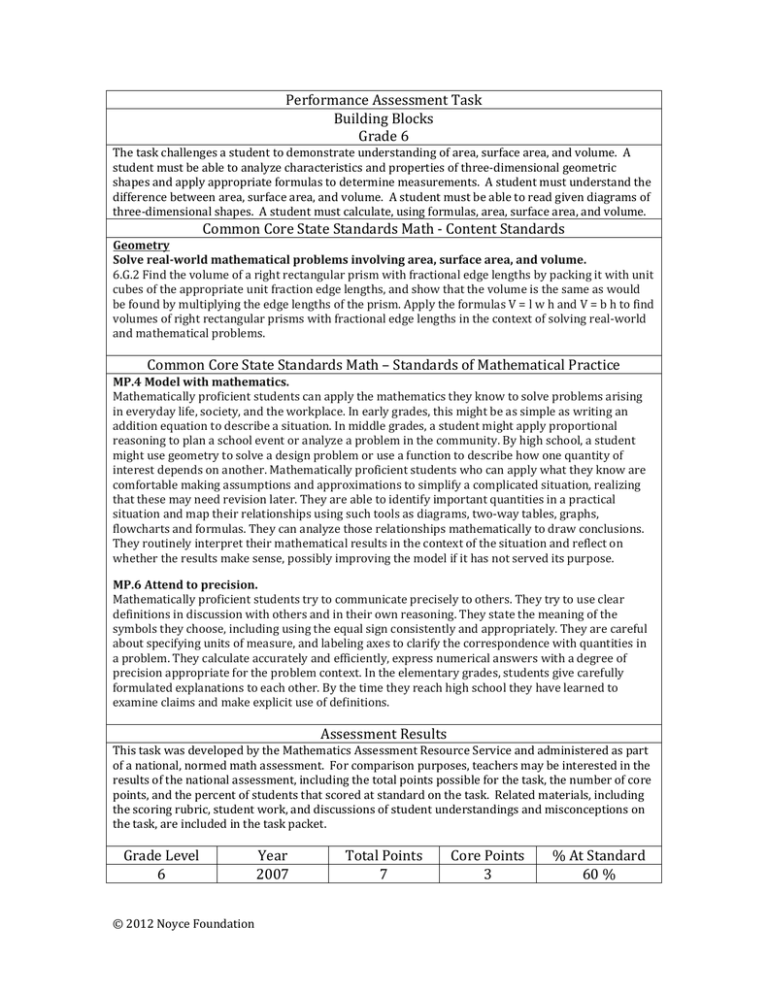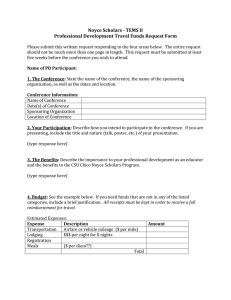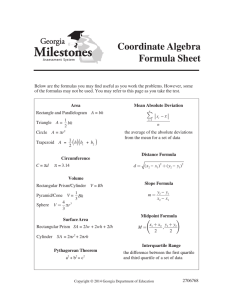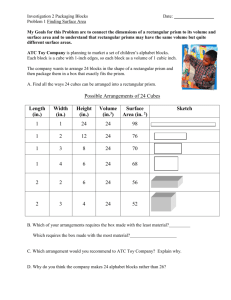
Performance Assessment Task
Building Blocks
Grade 6
The task challenges a student to demonstrate understanding of area, surface area, and volume. A
student must be able to analyze characteristics and properties of three-dimensional geometric
shapes and apply appropriate formulas to determine measurements. A student must understand the
difference between area, surface area, and volume. A student must be able to read given diagrams of
three-dimensional shapes. A student must calculate, using formulas, area, surface area, and volume.
Common Core State Standards Math - Content Standards
Geometry
Solve real-world mathematical problems involving area, surface area, and volume.
6.G.2 Find the volume of a right rectangular prism with fractional edge lengths by packing it with unit
cubes of the appropriate unit fraction edge lengths, and show that the volume is the same as would
be found by multiplying the edge lengths of the prism. Apply the formulas V = l w h and V = b h to find
volumes of right rectangular prisms with fractional edge lengths in the context of solving real-world
and mathematical problems.
Common Core State Standards Math – Standards of Mathematical Practice
MP.4 Model with mathematics.
Mathematically proficient students can apply the mathematics they know to solve problems arising
in everyday life, society, and the workplace. In early grades, this might be as simple as writing an
addition equation to describe a situation. In middle grades, a student might apply proportional
reasoning to plan a school event or analyze a problem in the community. By high school, a student
might use geometry to solve a design problem or use a function to describe how one quantity of
interest depends on another. Mathematically proficient students who can apply what they know are
comfortable making assumptions and approximations to simplify a complicated situation, realizing
that these may need revision later. They are able to identify important quantities in a practical
situation and map their relationships using such tools as diagrams, two-way tables, graphs,
flowcharts and formulas. They can analyze those relationships mathematically to draw conclusions.
They routinely interpret their mathematical results in the context of the situation and reflect on
whether the results make sense, possibly improving the model if it has not served its purpose.
MP.6 Attend to precision.
Mathematically proficient students try to communicate precisely to others. They try to use clear
definitions in discussion with others and in their own reasoning. They state the meaning of the
symbols they choose, including using the equal sign consistently and appropriately. They are careful
about specifying units of measure, and labeling axes to clarify the correspondence with quantities in
a problem. They calculate accurately and efficiently, express numerical answers with a degree of
precision appropriate for the problem context. In the elementary grades, students give carefully
formulated explanations to each other. By the time they reach high school they have learned to
examine claims and make explicit use of definitions.
Assessment Results
This task was developed by the Mathematics Assessment Resource Service and administered as part
of a national, normed math assessment. For comparison purposes, teachers may be interested in the
results of the national assessment, including the total points possible for the task, the number of core
points, and the percent of students that scored at standard on the task. Related materials, including
the scoring rubric, student work, and discussions of student understandings and misconceptions on
the task, are included in the task packet.
Grade Level
6
© 2012 Noyce Foundation
Year
2007
Total Points
7
Core Points
3
% At Standard
60 %
Being Building Blocks
This problem gives you the chance to:
• work with area and volume
Barbara’s baby brother, Billy, has a set of building blocks.
2
Each block is 2 inches long, 2 inches wide, and 2 inches high.
2
1. How many faces does the block have?
____________
2. What is the volume of the block?
____________ cubic inches
2
Show how you figured this out.
4
3. Billy has built this shape from his 2 × 2 × 2 blocks.
a. What is the surface area of the shape?
_____________ square inches
2
4
Show how you figured this out.
b. What is the volume of the shape?
_____________ cubic inches
Explain how you figured this out.
___________________________________________________________________
___________________________________________________________________
7
Copyright © 2007 by Mathematics Assessment
Resource Service. All rights reserved.
Page 72
Building Blocks Test 6
Task 5: Building Blocks
Rubric
The core elements of performance required by this task are:
• work with area and volume
points
section
points
Based on these, credit for specific aspects of performance should be assigned as follows
1. Gives correct answer: 6
1
2. Gives correct answer: 8 cubic inches
1
1
Shows work such as:
2x2x2=
1
2
or length x breadth x height
3 a. Gives correct answer: 64 square inches
1
Shows work such as:
2((4 x 4) + (4 x 2) + (4x 2))
1
b. Gives correct answer: 32 cubic inches
1
Gives explanation such as:
There are 4 cubes and each is 8 cubic inches. So 4 times 8 makes 32
1
4
or 4 x 4 x 2 =
Total Points
Copyright © 2007 by Mathematics Assessment
Resource Service. All rights reserved.
Page 73
7
Building Blocks Test 6
B uilding B locks
Work the task and look at the rubric. What are the key mathematical ideas being assessed?
L ook at student work for part 2, finding the volume of the original block. How many of your
students put:
8
6
4
24
12
10
Other
Why do you think students mightmake some of these errors? What are some of their
misconceptions?
Now look at student work for part 3, finding surface area. How many of your students put:
64
32
8
16
4
12
10
256
Other
What are the students doing? Can you figure outthe logic of their errors?
How many of your students made models or marked up the diagram to help them think throughthe
different pieces of surface area they were calculating?
How many of your students used labels aboutsides, tops, etc. to help them track what they had
calculated?
How many tried to multiply something by six, because there are six sides on the shape?
What types of experiences have your students had with calculating surface area?
Now look at student work for part 4. How many of your students put:
32
48
10
16
8
96
4
Other
Can you figure out where some of these answers are coming from? How are the misconceptions
different for different responses?
What types of activities and discussions will help students sort throughthe errors in their logic?
How many of the errors do you think result from students’ inability to visualize a shape in all
dimensions?
What activities or experiences do your students have to help them develop their spatial
visualization? How often do students get opportunities to sketch all the sides of a shape or try to
draw 3-dimensional shapes?
6th grade – 2007
Copyright © 2007 by Noyce Foundation
74
L ooking at Student Wor k on B uilding B locks
Student A is able to use the diagram to think aboutall the sides. T o find surface area, the student
has identified a unit (2 x4) and shown in the diagram how that unit is iterated 8 times aroundthe
surface.
Student A
6th grade – 2007
Copyright © 2007 by Noyce Foundation
75
Notice how Student B uses shading to help him visualize the different sides of the shape in part 3.
Student B shows calculations for each of the six sides for finding the surface area in part 3. T he
student is able to articulate and use a formula, butmakes a calculation error in 3b.
Student B
6th grade – 2007
Copyright © 2007 by Noyce Foundation
76
Student C does not visualize that the 6 sides are not of the same size in part 3.
Student C
6th grade – 2007
Copyright © 2007 by Noyce Foundation
77
Student D does notunderstand that surface area includes all the faces of the shape. T he student only
finds the surface area for oneface of the small block.
Student D
6th grade – 2007
Copyright © 2007 by Noyce Foundation
78
Student E divides the small shape into unit blocks and counts the blocks to find volume. T his
strategy continues in finding the volume in part 3b. T he student seems to have foundonly the
surface area of the front of the block in part 3b. What do you feel comfortable that this student
understands? What are you concerned about? What mightbe a goodnext task for this student?
Student E
6th grade – 2007
Copyright © 2007 by Noyce Foundation
79
I n looking at the Student F’ s work in part 2, she appears to understand the formula for volume.
However her thinking breaks down when applying the formula to the larger shape. Why do you
think the student doesn’t revert back to the original formula in 3b?Can you see anything in the
drawing that may have led to the expanded formula? What do you think the student is thinking about
in finding the area in part 2b? I s the student thinking 2 for a small square and there are 8 visible
small squares?
Student F
6th grade – 2007
Copyright © 2007 by Noyce Foundation
80
Understanding scale is difficult for students. I n part 3a Student G realizes that there are sixteen units
of the same size needed to cover the shape, but the student does not remember or isn’t able to think
aboutsquares that aren’t 1 square unit. What is the size of the student’ s identified unit? T he same
type of error occurs in 3b. T he student understands that four blocks or equal-sized units make up the
volume of the cube. B ut the blocks are not 1 cubic inch, but8 cubic inches. How do we help students
move fromunits of oneto units other than one?
Student G
6th grade – 2007
Copyright © 2007 by Noyce Foundation
81
Student H marks the diagram and like G comes up with 16 units instead of 16 units of 4 square
inches each.
Student H
Student I is attempting to countthe 16 units of 4 square inches, butisn’t able to unfold the shape
correctly when attempting to draw the net. I n part 2 the student seems to be finding a perimeter
instead of an area. I n part 3b the student is also attempting to add to find a perimeter instead of a
volume.
Student I
6th grade – 2007
Copyright © 2007 by Noyce Foundation
82
L ook at the work of Student J and Student K . What do you think they understand about3dimensional shapes? What do they understand aboutarea and volume? What experiences would be
goodto help these students develop a better understanding of these measurements?
Student J
6th grade – 2007
Copyright © 2007 by Noyce Foundation
83
Student K
6th grade – 2007
Copyright © 2007 by Noyce Foundation
84
6th G r ade
Student T ask
C ore I dea 4
G eometr y &
M easur ement
T ask 5
B uilding B locks
Work with area and volume using blocks of 2 x 2 x 2.
A nalyze char acter istics and pr oper ties of thr ee-dimensional
geometr ic shapes and apply appr opr iate formulas to deter mine
measur ements.
Select appropriate type of unit for measuring each attribute (volume may
be measured by filling an object.
Based on teacher observation, this is what sixth graders knowand are able to do:
Countthe number of faces on a rectangular block
Find the volume of a cube
Find the volume of a rectangular prism
Areas of difficulty for sixth graders:
Finding surface area of a rectangular prism
Spatial visualization of 3-dimensional shapes
A pplying a scale different than oneto a square being stamped or repeated to cover a
rectangular prism
6th grade – 2007
Copyright © 2007 by Noyce Foundation
85
The maximum score available on this task is 7 points.
The minimum score for a level 3 response, meeting standards, is 3 points.
Most students, 93%, knew that there are 6 faces on a cube. More than half the students could also
find the volume of a cubeand show how they figured it out. A little less than half, 42%, could also
find the volume of a rectangular prism. 11% of the students could meet all the demands of the task
including finding the surface area of a rectangular prism. 7% of the students scored no points on this
task. 80% of the students with this score attempted the task.
6th grade – 2007
Copyright © 2007 by Noyce Foundation
86
B uilding B locks
Points
Under standings
80% of the students with this score
0
attempted the task.
1
Students knew that there were 6 faces
on a cube.
3
Students knew the faces on a cube
and could find the volume of a cube.
5
Students knew the number of faces
on a cubeand could find the volume
of a cubeand a rectangular prism.
7
Students could reason about3dimensional shapes, thinking about
the number of faces and finding the
area of the faces. Students could also
find the volume for rectangular
prisms.
6th grade – 2007
Copyright © 2007 by Noyce Foundation
M isunder standings
Students had difficulty understanding the number
of faces on a cube. T he most common answers
were 3(faces visible in diagram) and 5 (usually
forgetting the bottom).
Students had difficulty finding volume of a cube.
9% thoughtthe volume was 8. 9% thoughtthe
volume was 12. 6% thoughtthe answer was 24.
Students had difficulty applying their knowledge
of volume of a cubeto finding volume of a
rectangular prism. 7% added the dimensions to
get a volume of 10. 4% thoughtthe volume was
48. 4% thoughtthe volume was 16. A nswers for
volume went as high as 512 and 1096.
T hey struggled with the idea of surface area of a
rectangular prism. A lmost 18% thoughtthe
surface area was 32. 16% thoughtthe surface area
was 16. 12% thoughtthe surface area was 8.
Other common answers were 4 and 12.
87
I mplications for I nstr uction
Students should know the formula for the volume of a rectangular prism and be able to substitute
numbers into the formula to calculate the volume. Alternately, students should be able to think
about how many blocks it takes to build the shape and multiply the volume of one-block times the
number of blocks. Students need more opportunities to draw or make representations of threedimensional shapes as tools for thinking about how the shape is composed or can be decomposed
into simpler shapes. Students, who struggle with drawing or representation, are more likely to ignore
or “not see” parts of the shape. Triangular dot paper is useful to recording three-dimensional shapes.
Students should also be able to find area of rectangular shapes and be able to organize that
information to find surface area. They might not think about the bottom or backside of the shape,
but should be able to find a majority of the areas of the surface of a prism. When students develop
the habit of mind of using the diagrams as tools for thinking, they are more successful. Simple
actions like adding size of the dimensions to more parts of the diagram can help them sort through
the parts to be considered.
I deas for A ction R esear ch – Using Student G ener ated Str ategies
Student work on this task brings up some interesting ideas aboutmeasurement and iterating units.
Having students use these ideas can push their thinking aboutthe shapes in some directions that may
help them generalize to other situations or back better connections to understanding where the
formulas come from.
Here are some questions you mightpose for the class:
I n trying to find the surface area, A lice says that she sees 8 equal size shapes that would cover the
outside of the blocks. What do you think A lice is looking at? Where are those shapes in the
drawing? What are the dimensions of A lice’ s shape? How could you mark off her shapes in the
diagram?
Give students some blank diagrams and consider giving them some blocks or linker cubes to build
the shape. (F or your reference look at the work of Student A.)
E rnie says that when he thinks aboutunfolding the shapes he counts 16 squares. What do you think
E rnie is looking at? Can you draw what E rnie is doing? Does this help him find the surface area?
Here, hopefully students will start to see the difference between the squares in the net and the size of
the squares. (F or your reference look at the work of Student E and G.)
Georgia says that she used a similar methodto find the volume of the cubes. First I broke the
original cubeinto smaller cubes, each oneby oneby one. Can you think what this would look like?
How would this help her find the volume? Can you draw what you think she did?
For the next question:
Georgia says that B illy used 4 blocks to build the shape so I use of volume of a block x 4. What is
Georgia’ s number sentence? Does this make sense? Would it work on other shapes made with the
blocks? Hold up some other rectangular prism and ask students to find the volume using Georgia’ s
method. Then have them use the volume formula. Will the answers come out the same?
(Look at work of Student E for the last two questions aboutGeorgia.)
6th grade – 2007
Copyright © 2007 by Noyce Foundation
88
Conner has a different strategy for finding surface area. He said that the area of the side was 2 x 4,
which is 8. T hen he said that there are 6 sides on the prism, so 6 x 8 is 48. Why does Conner have a
different answer from the onewe foundusing E rnie’ s strategy? Who do you think is right?
(See work of Student C.)
How do these types of questions help students develop an understanding of a unit and decomposing
shapes? How is this useful mathematically?
How do the questions help students confront and challengecommon misconceptions? Do you think
this helps students let go of some of their ways of thinking? What evidence did you see of students
changing their ideas?
R eflecting on the R esults for Sixth G r ade as a Wh ole:
T hink aboutstudent work throughthe collection of tasks and the implications for instruction. What
are some of the big misconceptions or difficulties that really hit home for you?
________________________________________________________________________________
I f you were to describe oneor two big ideas to take away and use for planning for next year, what
would they be?
________________________________________________________________________________
What are some of the qualities that you saw in good work or strategies used by goodstudents that
you would like to help other students develop?
________________________________________________________________________________
Four areas that stand out for the Collaborative as a whole are:
1. Understanding the Operation– Students had difficulty recognizing different types of division
actions to help them make sense of a situation. T hey did notunderstand aboutsignificant
digits or level accuracy that would apply to the context of the problem. Many students wrote
problems that did not describe a division situation. I f students have difficulty understanding
the action of division with whole numbers, then they will have problems trying to make
sense of operations with fractions and decimals. Many of the issues of division don’t come
up unless students are working in a context. Working sets of division problems ideas about
remainder and rounding do not apply. Students had difficulty matching problem descriptions
to calculations in Household Statistics. Often students did not even choose matches that had
the correct operations. B eing able to move from doing a series of individual calculations to
writing the steps into oneexpressions helps students generalize aboutproblem solutions and
sets the stage for later writing procedures down in symbolic notation in algebra.
6th grade – 2007
Copyright © 2007 by Noyce Foundation
89
2. Probability – Some students did not understand the idea of probability as a chance or a
prediction. T hey looked ahead for actual outcomes. Others did notunderstand the idea of
“random” or “equally-likely” events. T hey tried to find a pattern in the information.
Students did notunderstand how to define sample space and therefore had difficulty
quantifying probabilities.
3. Understanding Scale and Frequency – I n the data task, Household Statistics, students had
trouble distinguishing between categories, number of children in a household, and frequency,
how many households had that number of children. T his made it difficult for them to find
totals. T hey may have added number of categories or the numbers on the scale instead of the
quantities being represented by the bars on the graphs. I n B uilding B locks students may have
identified a unit, how many cubes fit inside a shape or how many squares it takes to cover a
shape, butthey often forgot to consider the size of the unit. T hey may have only worked
with units of one.
4. Finding Patterns with Number Properties – Students had difficulty finding or describing
some of the patterns in Factors. T hey are still only considering properties like oddand even.
T hey are notcomfortable with prime, square, and other more complex types of patterns. A s
students progress throughthe grades, the types of patterns or thinking they do needs to be
more complex or deeper than work from previous grades. Students are also trying to apply
patterns or find patterns in situations where patterns do not apply, like probability.
6th grade – 2007
Copyright © 2007 by Noyce Foundation
90





